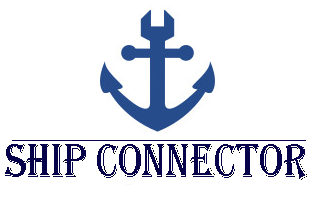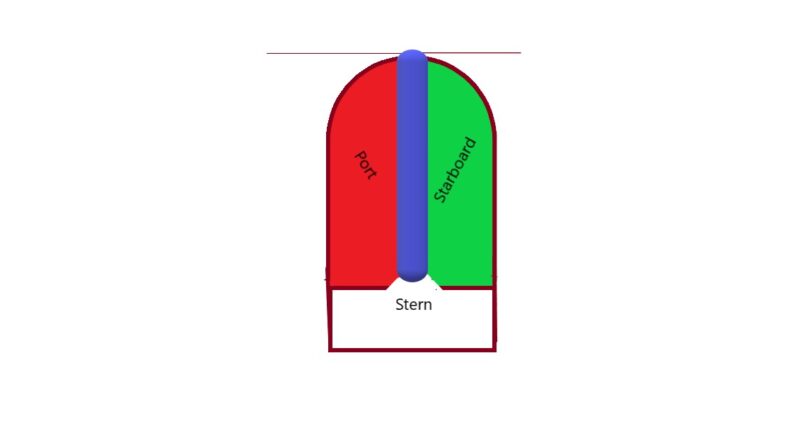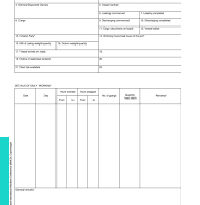Port side and Starboard side of a ship
The ship is divided into two equal halves, the right and left halves irrespective of where the observer is. These halves are the port(left side) and starboard (right side).
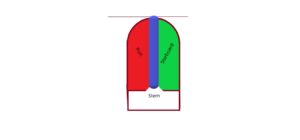
In Earlier times and even today the rudder is used to give movement to the ship may be right or left side, the rudders was fixed on their centre line and was controlled with the help of steering oar,with the steeringman facing forward, majority of the people are right handed, therefore the steering oar which control the ship was placed over the right side of the stern.
Therefore the seafarers were calling the right side as the ‘steering side’, as they were steering with the help of right hand, later steering side was converted to ‘starboard’.
The word ‘starboard’ is the combined using two words: stéor (meaning ‘steer’) and bord (meaning ‘the side of a boat’).
The left side is called as port side as rightside is already given name of steerboard or star board but when ships gets alongside on the left hand side then that side use to face port ,so from there name came as port side and since then left side of the ship is named as port side
When the ship was moored left side of the port was said to be larboard,but both words starboard and larboard was quit confusing to hear as they sounds almost same when command is given to the steeringman ,so later larboard was replaced by term port
Commands Example-hard a port/hard a starboard
Meaning rotate wheel full to port side or starboard side
Now the right side was named as steerboard side or star board side, the left side was named as the port side.
One more reason why the left side is ‘port’ is because it sounds different from ‘starboard’,and sounds clearly to the steering man or the helmsman.
FAQ
What are the 4 sides of a ship
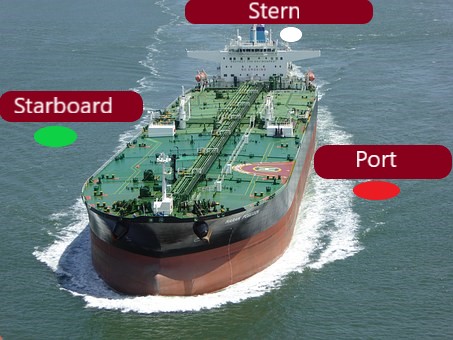
Forward and Aft of the ship
Forward ,Foxil or Bow are the front part of the ship and Stern is the Aft part of the ship
Port red and starboard green
Sidelights means a green light on the Starboard side and a red light on the port side each showing an unbroken light over an arc of the horizon of 112.5 degrees and so fixed as to show the light from right ahead to 22.5 degrees abaft the beam on its respective side.
Credit:ROR Book
Gunwale /Gunnel
It is the outermost top edge of a vessel hull, where the deck and hull meet together.
Ships Directions
Abaft – further back from a location, e.g. abaft the beam means backside of beam
Aboard: on a ship
Aft –Back part or toward the stern of a ship
Adrift: floating in the water without the use of propulsion.
Aground: keel touching the shore or seabed
Ahull: structure of a vessel
Alee: on or toward the lee
Aloft: the masts or other area which is the highest structure
Amidships: the middle part of a ship
Aport: the port side of a ship
Ashore: on shore or land
Astarboard: the starboard side of a ship
Astern: toward the aft of a ship
Athwartships: toward the sides of a ship
Aweather: the windward side of a ship
Aweigh: anchor just clear of the sea bed
Belowdecks: down to a lower deck
Bilge: it is the compartment where suction pump mouth is placed to suck water out
Bottom: the lowest part of the ship
Bow: front part of a ship
Centerline : an imaginary line drawn from the bow to the stern which divides ship in two equal halves
Fore or forward: the front part of a ship
Inboard: inside the ship
Keel: the bottom flat steel plate,the structure of the ship sits on this plate
Leeward: side of a ship which is away from the wind
On deck: its on the deck where crew walks
On board: on the ship
Outboard: attached outside the ship
Port: the left side of the ship
Starboard: the right side of the ship
Stern: the aft part of a ship
Topside: the top portion of a ship
Underdeck: a lower deck of a ship
Yardarm: an end of a yard spar below a sail
Waterline: where the water surface meets the ship’s hull
